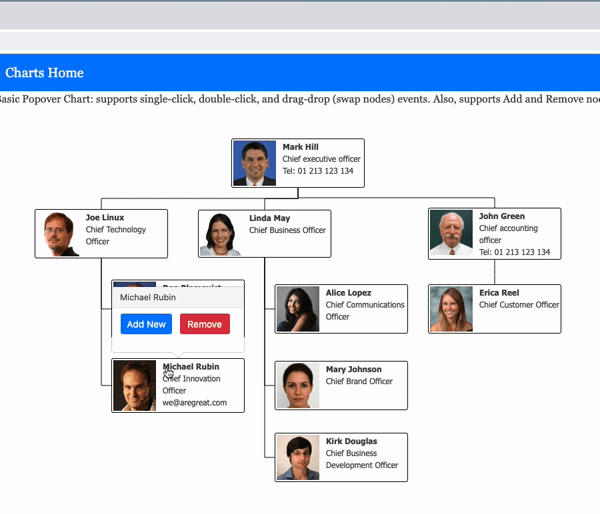A simple Angular2+ component used as a wrapper for TreantJS library for visualization of tree (chart) diagrams, with additional functionality. 🔥🔥🔥
Demo 🎥
npm install @ahmed757/ngx-treant-js --saveAdd required dependencies to angular.json as follows:
...
"styles": [
"node_modules/treant-js/Treant.css",
"node_modules/treant-js/vendor/perfect-scrollbar/perfect-scrollbar.css",
"src/styles.css"
],
"scripts": [
"node_modules/jquery/dist/jquery.min.js",
"node_modules/popper.js/dist/umd/popper.js",
"node_modules/treant-js/vendor/jquery.easing.js",
"node_modules/treant-js/vendor/jquery.mousewheel.js",
"node_modules/treant-js/vendor/perfect-scrollbar/perfect-scrollbar.js",
"node_modules/treant-js/vendor/raphael.js",
"node_modules/treant-js/Treant.js"
]
...See full example here.
- Easy to integrate and use in any
Angularapplications - Provide
callbackfunctions to react to user's actions, e.g. single-click, double-click, drag-drop, hover, etc - provide
drag-dropfeature for swapping (re-positioning)Treenodes - Support adding & removing
Treenodes - Support editting
Node's content, e.g.name,title, etc
employess-chart.component.html
<ngx-treant-chart
[chartId]="employeesChartId"
[chartClass]="employeesChartClass"
[data]="employeesData">
</ngx-treant-chart>employess-chart.component.ts
export class EmployeesChartComponent {
employeesChartId = 'employessChart-commpany';
employeesChartClass = 'employess-chart';
employeesData = {
chart: {
container: "#employessChart-commpany",
connectors: {
type: 'step'
},
node: {
HTMLclass: 'employessNode'
}
},
nodeStructure: {
text: {
name: "Paul Young",
title: "Chief executive officer",
contact: "Cel: 01 213 123 134",
},
image: "assets/images/img1.jpg",
children: [
{
text:{
name: "John Doe",
title: "Chief Technology Officer",
},
stackChildren: true,
image: "assets/images/img2.jpg",
children: [ ... ]
}
]
}
}
}styles.css
...
.employess-chart {
height: 600px;
margin: 5px;
width: 900px;
}
.Treant> p {
font-family: "HelveticaNeue-Light", "Helvetica Neue Light", "Helvetica Neue", Helvetica, Arial, "Lucida Grande", sans-serif;
font-weight: bold;
font-size: 12px;
}
.node-name {
font-weight: bold;
}
.employessNode {
padding: 2px;
-webkit-border-radius: 3px;
-moz-border-radius: 3px;
border-radius: 3px;
background-color: #ffffff;
border: 1px solid #000;
width: 200px;
font-family: Tahoma;
font-size: 12px;
}
...See full example here.
Note: 💡 In a real world application, the data would most likely come from a server or remote place, which means that we would need to initialize NgxTreantChart only when data arrives. Therefore, *ngIf can be used as a workaround as follows:
<ngx-treant-chart
...
*ngIf="isDataLoaded">
</ngx-treant-chart>| Attributes | Description |
|---|---|
[chartId] |
The chart uniqe ID (required) |
[chartClass] |
The chart CSS class uniqe name (optional) |
[data] |
The data used for visualization of chart diagrams (required) |
[popoverSettings] |
The settings used for customizing a popover (optional - see example) |
[mouseleaveMilliseconds] |
The mouseleaveMilliseconds delay used prior to a popover being hidden (optional) |
[isDraggable] |
A boolean flag used to enable drag & drop support (optional) |
(clicked) |
A callback function invoked when a TreeNode is clicked |
(hovered) |
A callback function invoked when a TreeNode is mouse hovered |
(dragged) |
A callback function invoked when a TreeNode is dragged |
(dropped) |
A callback function invoked when a TreeNode is dropped |
(updated) |
A callback function invoked when TreeNode's content is updated on dblclick event |
(loadedNodes) |
A callback function invoked when TreeNodes are loaded |
(loadedTree) |
A callback function invoked when the Tree is loaded |
(loadedTreant) |
A callback function invoked when the Treant is loaded |
- The callback functions:
clicked,hovered, andupdatedreturn a value ofObjecttype, which consists of two properties:
Node: instance ofTreeNodetype for the node that was modified$:jQueryinstance, which can be used to perform any additional desired functionality that requiresjQuery
<ngx-treant-chart
...
(clicked)="onClick($event)">
</ngx-treant-chart>onClick(event: any): void {
/*
event: {
node: {
X: 106
Y: 259.5
children: (3) [1, 4, 19]
collapsable: undefined
collapsed: undefined
connStyle: {type: "step", style: {…},
stackIndent: 15}
drawLineThrough: undefined
height: 30
id: 0
image: undefined,
...
},
$: ƒ (e,t)
}
*/
}- The callback function
draggedreturns an object which contains an instance ofTreeNodetype as well asjQueryas follows:
{
draggedNode: {
X: 106
Y: 259.5
children: (3) [1, 4, 19]
collapsable: undefined,
...
},
$: ƒ (e,t)
}- The callback function
droppedreturns the following:
draggedNode: the dragged node ofTreeNodetypedroppedNode: the dropped node ofTreeNodetype$:jQueryinstance
-
The callback function
loadedNodesreturns allTree(chart) nodes. -
The callback function
loadedTreereturns an instance ofTree(chart) type. The instance provides useful properties and functions, such asnodeDBandpositionTree(), which can be used to update tree (chart) nodes:
...
onLoadTree(tree: any): void {
const nodes = tree.nodeDB;
// do something with nodes
tree.positionTree(); // apply changes
}- The callback function
loadedTreantreturns an instance ofTreanttype. The instance consists ofcontainer_idandtree_id:
...
onLoadTreant(treant: any): void {
console.log(treant);
/* example
{
container_id: "employessChart-commpany",
tree_id: 0
}
*/
treant.destroy(); // destroy tree
}



